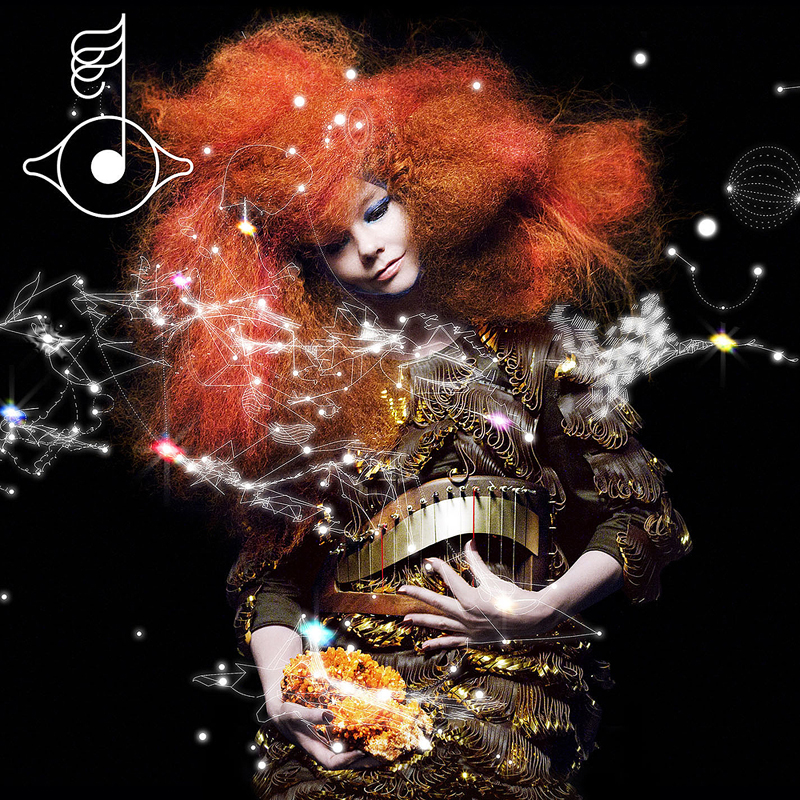Carbon is the building block of life, the one thing on this planet that connects humans to the vast extraterrestrial unknown. Nobody understands this better than Björk. Nature is and has always been central to her work: Vespertine saw Björk reconciling her awe of worlds external and wintry, internal and domestic; Medúlla was a return to an ancient time when vocal chords and a natural environment were the only ingredients necessary write a melody; Volta was a tribal, volcanic tribute to the pagan feminine. For Biophilia, Björk has produced a veritable dissertation on humankind’s relationship to the natural world, and she’s done it with utterly gorgeous instrumentation that’s just as stark as it is lush.
As much as Biophilia represents a significant shift in Björk’s sound, it’s also a natural extension of her career trajectory. Her latest effort is a deeper thesis on the relationship between the natural world and human nature, looking out into the universe as well as Mother Earth — exploring how the universe came into being, how humans orient themselves to the universe, how lifeforms evolve and coexist. Musically, Björk represents these topics by using arrangements that ebb and flow between basic and complex, fusing the strongest elements of the earthy Medúlla and Volta with the delicate, ethereal sounds of Vespertine: aggressive beats against icy instrumentation; a deep, throaty voice against a celestial choir; masculine-sounding instruments against feminine-sounding instruments. The juxtaposition is everywhere, and it is refreshingly consistent.
It is nigh impossible to talk about Biophilia in simplistic language. This is modern academic music at its most impressive, and make no mistake about it: Björk is a serious student of her art. The album is informed by canonical composers such as Benjamin Britten: in fact, “Thunderbolt” echoes Britten’s church music and slowly develops from the pastoral to the modern with steady, deep synths closing out the song. While brass was a recurring theme in Volta, Biophilia boasts intricate organ arrangements, one of the more beautifully baroque characteristics of the album that draws inspiration from Vespertine. At the same time, Biophilia presents some of the most impressive electronic production that Björk has ever written or commissioned. “Crystalline” features some School of Venetian Snares breakcore (courtesy of London’s 16bit) that concludes the song by jackhammering into the gameleste’s icy sculptures. The equally-crunchy beats in “Thunderbolt” amble along at a stroller’s pace but still manage to move the song forward from quasi-baroque to contemporary. In “Mutual Core,” a tectonic-themed song with thick, rumbling production, the electronic backdrop supplies a sinister tone: “You didn’t know that I had it in me,” Björk warns from the Earth’s perspective, reminding us of nature’s indiscriminate power.
Björk has largely abandoned traditional pop format in favor of non-traditional songwriting, a major switch from Volta, which featured several Timbaland collaborations and thus some of her most radio-friendly music to-date. The unfocused, impulse-driven vocal melodies on Biophilia will be the key complaint from detractors, but this album — and this project — is simply not the place for pop-friendly melodic structures. Björk still has that otherworldly ability to breathe poignant prosody or a well-placed falling tone into certain words or entire lines. The closing melodies in “Sacrifice” stir up plenty of fluttery feelings — no feel-good, auto-tune pop necessary.
Just as carbon gives rise to a crystal or an entire galaxy, Björk’s creativity generates all these strands of DNA, all of which has permeated subsequent generations and influenced our lives as music listeners in myriad ways. Biophilia is Björk, the sum total, and this album is her continued claim to the throne as the monarch of avant-pop.


